Bayan Aldris*1; Nahed Farhoud1
1, Department of environmental engineering, Aleppo University, Aleppo, Syrian Arab Republic
E-mail:
bayanmohmad2015@gmail.com
Received: 04/12/2019
Acceptance: 22/01/2020
Available Online: 23/02/2020
Published: 01/04/2020
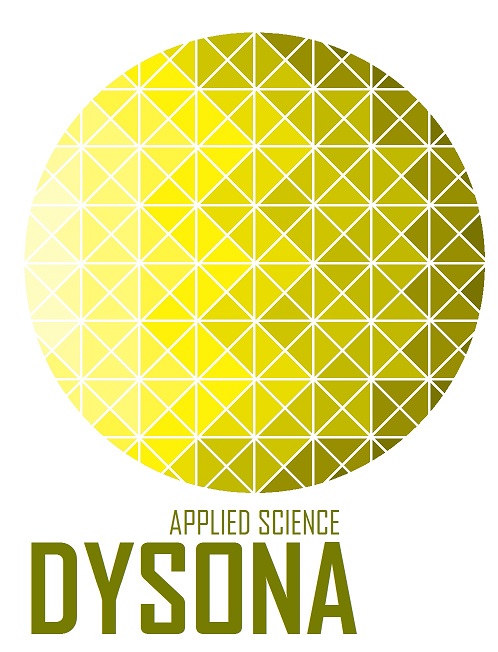
Manuscript link
http://dx.doi.org/10.30493/das.2020.103717
Abstract
One of the major concerns of today’s world is water security. The rapid developments in biochemical studies have opened the door for more progress in the biological water treatment method. Moving-bed biofilm reactor (MBBR) system is one of the relatively new water treatment methods which have witnessed a rapid expansion in numbers during the past few years. In this work, an experimental MBBR system was built and monitored throughout a startup period for treatment efficiency until a constant value of COD at 110 mg/l after 42 days when the reactor was considered efficiently started up. Different hydraulic retention times were evaluated and a treatment time of 6 h was chosen as the most efficient to reach the Syrian (Class a) irrigation water quality. Regression relationships of COD, TDS, NO3–, and PO4-3 indices before and after treatment were studied by implementing an increased influent load for each index with 6 h HRT treatment. Depending on regression equations, the maximum feeding concentration to reach the Syrian (Class a) irrigation water quality was calculated for each index. It was found that using the designed experimental system and 6 h HRT treatment, COD, TDS, NO3–, and PO4-3 in wastewater should be below 1997.4, 2122.86, 55.04, and 20.96 mg/l respectively.
Keywords: Wastewater, Biological treatment, MBBR
Abbreviations: Moving-bed biofilm reactor (MBBR), Chemical oxygen demand (COD), COD removal (CODr), Total dissolved solids (TDS), Hydraulic retention time experiment (HRT)
Introduction
Water security is one of the major concerns nowadays, as it is predicted that half Earth inhabitants will be facing water shortages by the year 2030 [1]. Water resources pollution in addition to population and industrial growth, had increased the need to find suitable and effective ways for water treatment [2][3]. Both organic and inorganic wastewater pollutants are present in either suspended or dissolved state, and while the suspended pollutants are easily separated by sedimentation, dissolved compounds are difficult to remove; however, there is a large portion of biodegradable organic substances such as carbohydrates and alcohols which are a nutritional source of bacteria and microalgae [4].
The rapid evolution in chemistry and biology has opened the door for biological wastewater treatment using microalgae and bacteria with high efficiency in nutrient removal (Phosphorus and Nitrogen), reduction of chemical oxygen demand (COD) and biological oxygen demand (BOD) [5-12]. Biological wastewater treatment is based upon a simple methodology; however, there are many complications in treatment condition management such as pH levels [13] and toxic shock due to the presence of various chemical compounds in treated water [14].
Moving-bed biofilm reactor (MBBR) is an alternative and efficient way to treat different types of wastewater under different conditions [15][16]. Due to its effectiveness and simplicity, this technology has grown from 400 fully operating MBBR reactor to more than 1200 in recent years [15]. This method operates similarly to the integrated fixed-film activated sludge (IFAS) method [17] with the addition of free movement of the bacterial mass carrying medium. More specifically, this technique relies on the growth of a biological membrane adhered to suspended substances in moving conditions within the reactor. The advantages of MBBR outweigh those of activated sludge through better oxygen transport, lower hydraulic residual time, greater organic loading rate, higher nitrification rate and more surface area of biomass [18][19][20].
Many studies were conducted to optimize MBBR startup and operational parameters [21][22][23]. This study aims to evaluate the operational parameters of an experimental MBBR system and to optimize its startup and retention times by measuring deferent water biochemical indicators.
Material and Methods
Experimental MBBR system description
The reactor was a glass tank with a capacity of 25 L followed by a 5 L settler tank. The system contained two pumps: an air pump that provides the reactor with air through the jets at the bottom of the tank and a second water pump that circulates water within the reactor. Cylindrical shape plastic carrier centers (11*7mm) were used in the reactor (30% of the reactor volume) as an adherence surface for the formation of a biofilm. The reactor was equipped as well with valves and plastic pipes for water pumping and discharging (Fig. 1).
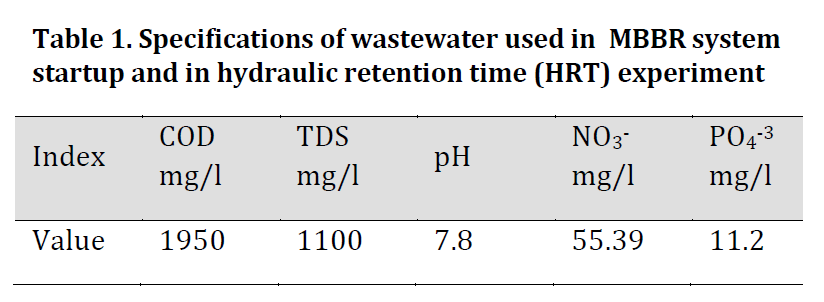
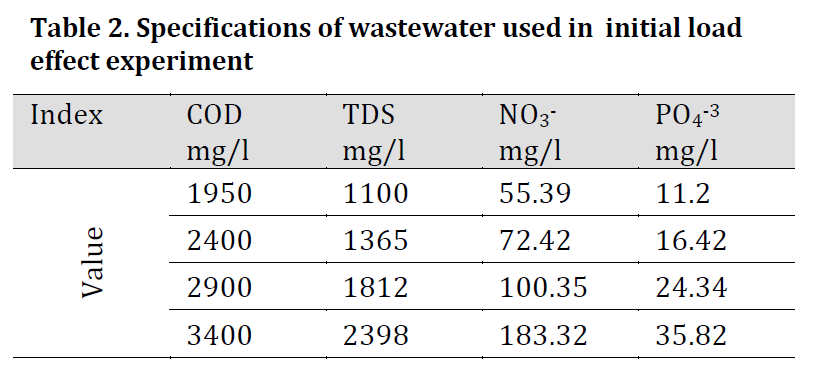
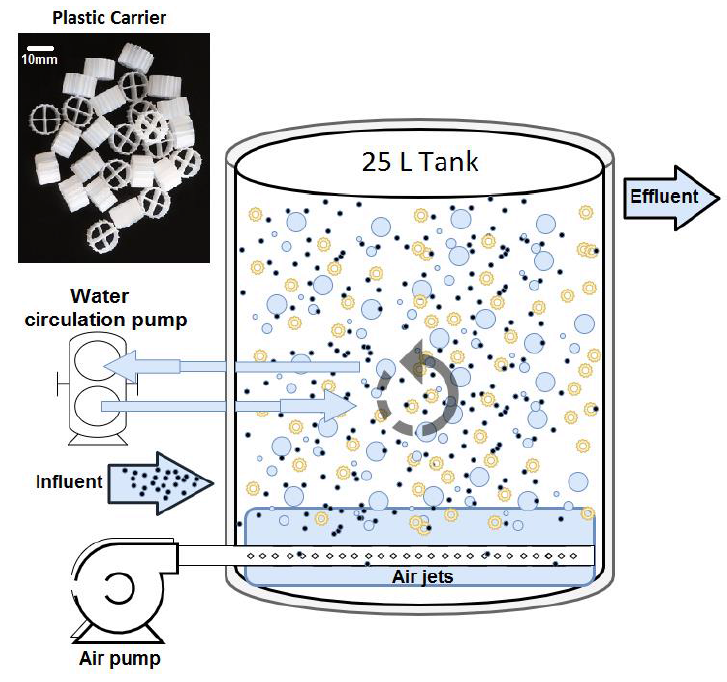
Influent water quality and analytical methods
Activated sludge and wastewater were obtained from a fully functional local water treatment facility. Wastewater had the specifications shown in (Table 1).
Chemical oxygen demand (COD), total dissolved solids (TDS), in addition to NO3–, and PO4-3 concentration were continuously monitored considering APHA A. WPCF (2005) standard water examination methods [24]. COD was determined using COD Set-Up MD 200 (Lovibond – Germany). The pH and TDS were measured using Jenway 3540 pH and conductivity meter (Jenway – UK). NO3– and PO4-3 concentrations were determined at 230 nm wavelength absorbance using Hach chemistry detection kits (Hach – USA) with OPTIZEN POP UV-Vis spectrophotometers (Mecasys – Korea) and according to manufacturer instructions.
COD and TSD for the wastewater within the reactor were monitored every 3 days throughout a startup enclosed wastewater circulation period. After the startup phase (42 days) and based on the monitored biochemical indices, the reactor was considered started. MBBR efficiency was then evaluated for different hydraulic retention time (HRT) periods (3, 4, 5, 6, 7, and 8 h). The water used in retention time experiment had the same specifications shown in (Table 1). The reactor efficiency was also evaluated with different feeding concentrations for the studied indices (Table 2) with a chosen water retention time of 6 h.
Mathematical computations
The following formulas were used to calculate removal efficiency indices:
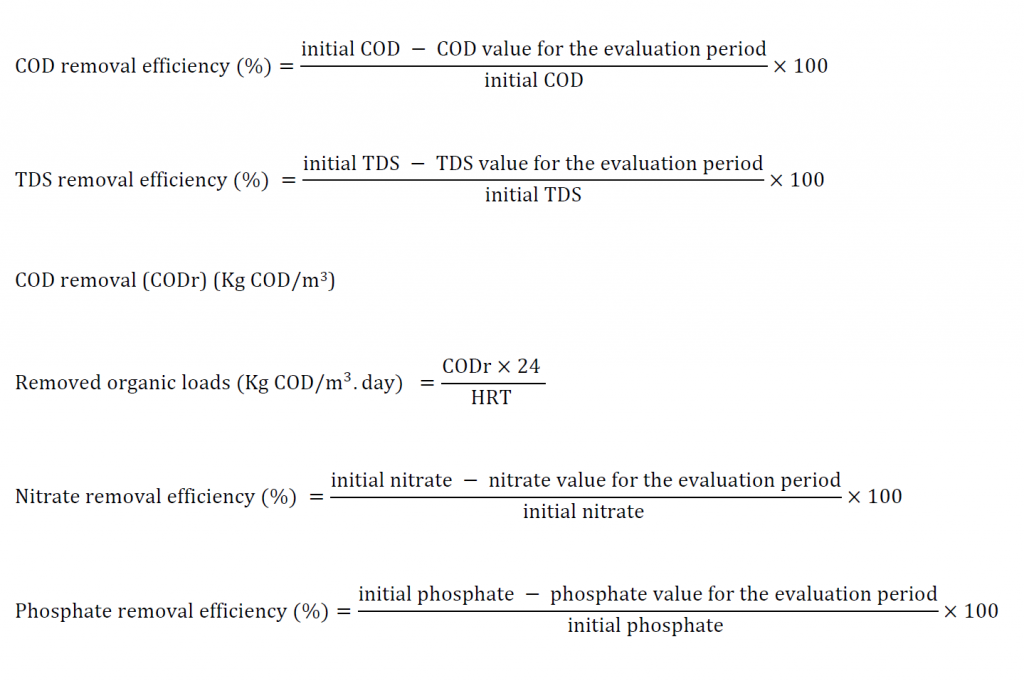
Statistical analysis
COD and TDS removal efficiency means were compared using Fisher’s Least Significant Difference (LSD) test at (p=0.05) using Minitab 19.2 software.
Graphs were plotted, and the linear regression relationship for each index before and after treatment for different initial loadings was calculated using GraphPad Prism 7 software.
Results and Discussion
MBBR startup phase monitoring
Water quality was monitored throughout the startup phase. Results illustrated that COD and TDS values decreased with increasing startup and reached a value of 110 and 608 mg/l respectively after 42 days of initiation (Table 3) and (fig. 2 A) with COD and TDS removal efficiency of 94.4% and 44.73% respectively (fig. 2 B). The gradual improvement in treatment efficiency throughout startup time is predictable due to the formation of larger biomass over time. The steady COD after 42 days of constant water influent refers to the full development of biofilm on the carrier and suggests reaching the stable working phase [22].
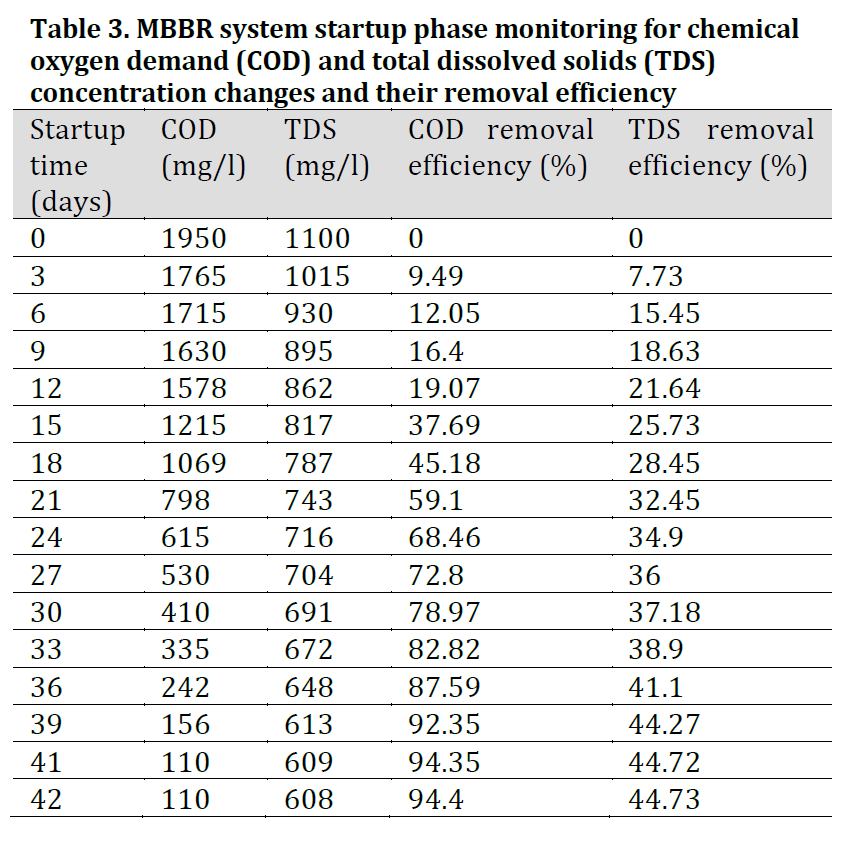
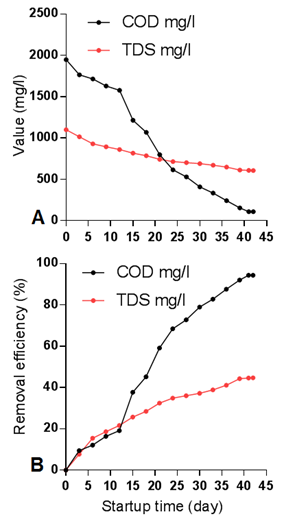
HRT effect on MBBR efficiency
Reactor efficiency was evaluated for six HRT times (3, 4, 5, 6, 7, and 8) h. The concentration of pollutants was decreased with the increase of hydraulic residue time and 8 h retention time registered the lowest COD value of 25 mg/l which is similar to the results of [25] and in correspondence with [26][27] results who reported an increase in effluent COD levels by decreasing HRT. Furthermore, It can be noticed that the Syrian (Class a) standard for treated wastewater for agricultural irrigation uses [28] was reached after 6 h retention time period with 70, 660, 17.87, and 4.79 mg/l for COD, TDS, NO3– and PO4-3 concentrations respectively (Table 4) and (Fig. 3 A and B). However, CODr values illustrated that by increasing HRT from 3 to 8 h, the removed COD weight on daily basis will decrease gradually from 10.88 to 5.78 Kg COD/m3.day, respectively and this decrease was significant with each additional HRT after 4 h. These results can be justified due to the fact that most of COD load was removed with 4 h HRT treatment (94.1% COD removal) which rendered the longer HRT treatments useless in terms of COD removal (Table 4) and (Fig. 3 C). The short HRT treatments were reported to disrupt the bacterial growth which thereafter decreases the efficiency of the system [29]; therefore, HRT treatments of more than 5 h were recommended [25].
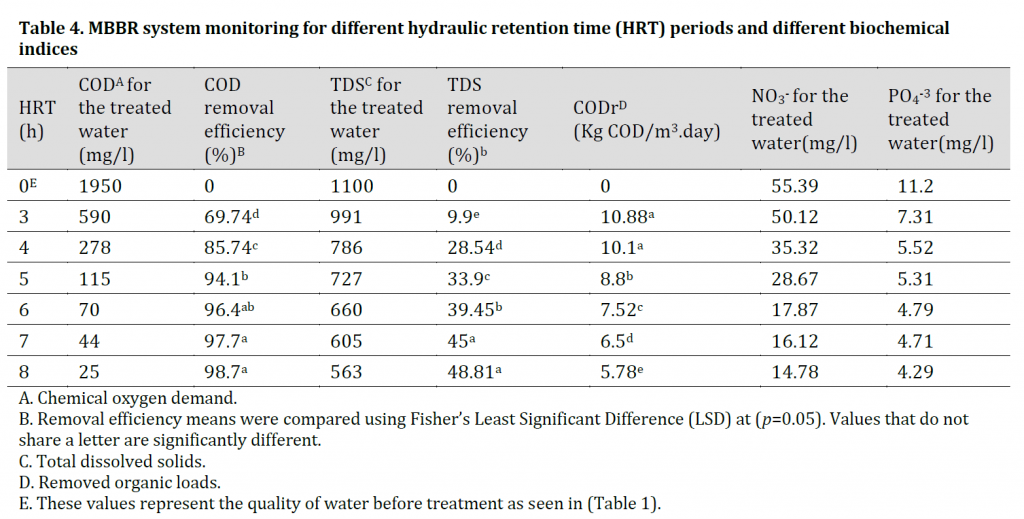
COD removal efficiency increased from 69.74% to 98.7% by increasing HRT treatment from 3 to 8 h. Furthermore, TDS removal efficiency increased from 9.9% to 48.82% for 3 and 8 HRT respectively showing a significant increase until 7 h treatment; however, with 96.4% COD removal efficiency, there was no significant difference between 6 h treatment and longer treatments (Table 4) and (Fig. 3 D). Therefore, and based on previous results that recommended 6 h treatment for domestic wastewater MBBR plants[26], 6 h treatment was chosen as the most efficient HRT to reach the Syrian (Class a) irrigation water quality.
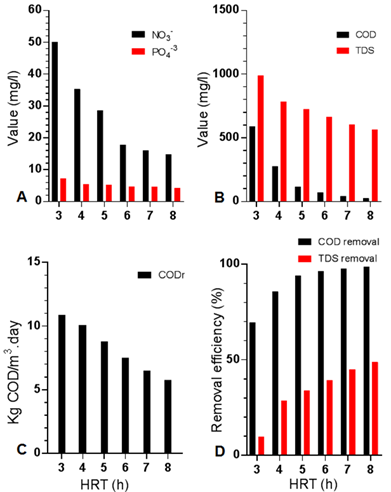
The effect of initial COD and nutrients load on MBBR Efficiency
The effect of initial COD, TDS, NO3–, and PO4-3 on MBBR treatment efficiency was studied. Treated water COD, TDS, NO3–, and PO4-3 increased by increasing their initial inputs which means that there was a decrease in removal efficiency (Tables 5 and 6). This decrease is attributed to the lack of biomass required to sustain the removal of the high organic load. The decrease in removal efficiency was previously reported by increasing influent COD in sequencing batch reactors (SBRs) [30], up-flow anaerobic sludge blanket digestion (UASB) reactors [31], anaerobic baffled reactor (ABR) [32], and in MBBR [33]. Furthermore, denitrification and the treatment efficiency of membrane biofilm reactor (MBfR) were drastically decreased when nitrate influent was greater than 120 mg/l [34].


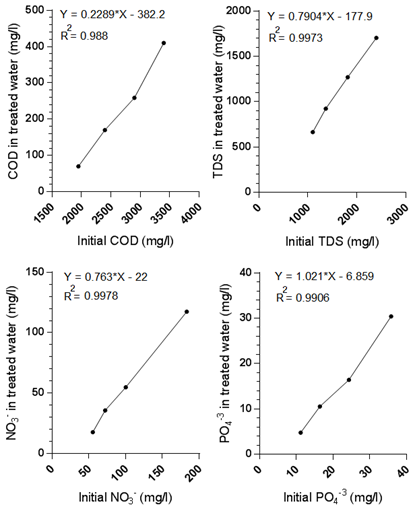
Linear regression relationship between the initial COD, TDS, NO3–, and PO4-3 concentrations of raw water and treated water were:
- Y = 0.2289*X – 382.2 (Fig. 4 A)
- Y = 0.7904*X – 199.9 (Fig. 4 B)
- Y = 0.763*X – 22 (Fig. 4 C)
- Y = 1.021*X – 6.8593 (Fig. 4 D)
These equations, to calculate the maximum wastewater concentration in order to reach (Class a) irrigation water quality according to the Syrian standard [28] with a COD, TDS, NO3–, and PO4-3 of 75, 1500, 20, and 15 mg/l respectively and a hydraulic retention time of 6 h. Results showed that initial COD, TDS, NO3–, and PO4-3 in wastewater should be below 1997.4, 2122.86, 55.04, and 20.96 mg/l respectively in order to achieve the quality of (Class a) irrigation water based on the Syrian standards with the chosen HRT of 6 h. These results indicate that our system can be classified among the highly efficient laboratory-scale systems in terms of COD removal [27][22] especially for a single phased aerobic reactor. The dramatic decrease in NO3– and PO4-3 removal efficiency by increasing their input levels (Table 6) might be partially alleviated by increasing HRT as seen in (Table 4); however, the increased levels of these pollutants might endanger the whole system with the prospect of a toxic shock [14]. Previously, it was reported that high Nitrogen and Phosphorus input in MBBR systems can be removed by adding an additional anaerobic phase with certain operating protocol [35]; therefore, the single phased aerobic system reviewed in the current experiment is only recommended for wastewater treatment with low Nitrate and Phosphate levels.
Conclusions
The experiment showed that the most efficient HRT for the designed MBBR system was 6 h. Regression analysis showed that the maximum influent feed for COD, TDS, NO3–, and PO4-3 in wastewater should be below 1997.4, 2122.86, 55.04, and 20.96 mg/l respectively in order to achieve the quality of the Syrian (Class a) irrigation water under 6 h HRT treatment. Furthermore, the single phased aerobic MBBR system can be recommended as a simple method of wastewater treatment with high COD and low Phosphorus and Nitrogen inputs.
More studies are required to investigate effect different organic and inorganic loads on treatment efficiency, and to evaluate different starter media and carrier materials under Syrian conditions and water standards.
References
| 1 | Fane AG, Wang R, Hu MX. Synthetic membranes for water purification: status and future. Angewandte Chemie International Edition. 2015;54(11):3368-86. DOI |
| 2 | Karuppaiah L, Suntharam R, Perumal M. of tannery effluent using Lyngbya Sp. with coir pith. Int J Sci Res. 2015;4(1):2736-43. |
| 3 | Cheremisinoff PN. Handbook of water and wastewater treatment technology. Routledge; 2019. |
| 4 | Metcalf L, Eddy HP, Tchobanoglous G. Wastewater engineering: treatment, disposal, and reuse. 4th ed. NewYork: McGraw-Hill; 2004. |
| 5 | Wang Y, Ho SH, Cheng CL, Guo WQ, Nagarajan D, Ren NQ, Lee DJ, Chang JS. Perspectives on the feasibility of using microalgae for industrial wastewater treatment. Bioresour. Technol. 2016;222:485-97. DOI |
| 6 | Hammouda O, Abdel-Raouf N, Shaaban M, Kamal M, Plant BS. Treatment of mixed domestic-industrial wastewater using microalgae Chlorella sp. J. Am. Sci. 2015;11(12):303-15. |
| 7 | Liang Z, Liu Y, Ge F, Xu Y, Tao N, Peng F, Wong M. Efficiency assessment and pH effect in removing nitrogen and phosphorus by algae-bacteria combined system of Chlorella vulgaris and Bacillus licheniformis. Chemosphere. 2013;92(10):1383-9. DOI |
| 8 | Lee K, Lee CG. Effect of light/dark cycles on wastewater treatments by microalgae. Biotechnol. Bioprocess Eng. 2001;6(3):194-9. DOI |
| 9 | Wang L, Li Y, Chen P, Min M, Chen Y, Zhu J, Ruan RR. Anaerobic digested dairy manure as a nutrient supplement for cultivation of oil-rich green microalgae Chlorella sp. Bioresour. Technol. 2010;101(8):2623-8. DOI |
| 10 | Cai W, Zhao Z, Li D, Lei Z, Zhang Z, Lee DJ. Algae granulation for nutrients uptake and algae harvesting during wastewater treatment. Chemosphere. 2019;214:55-9. DOI |
| 11 | Calderón K, Martín-Pascual J, Poyatos JM, Rodelas B, González-Martínez A, González-López J. Comparative analysis of the bacterial diversity in a lab-scale moving bed biofilm reactor (MBBR) applied to treat urban wastewater under different operational conditions. Bioresour. Technol. 2012;121:119-26. DOI |
| 12 | Tang CC, Zuo W, Tian Y, Sun N, Wang ZW, Zhang J. Effect of aeration rate on performance and stability of algal-bacterial symbiosis system to treat domestic wastewater in sequencing batch reactors. Bioresour. Technol. 2016;222:156-64. DOI |
| 13 | Lee SM, Jung JY, Chung YC. Measurement of ammonia inhibition of microbial activity in biological wastewater treatment process using dehydrogenase assay. Biotechnol. Lett. 2000;22(12):991-4. DOI |
| 14 | Kelly CJ, Lajoie CA, Layton AC, Sayler GS. Bioluminescent reporter bacterium for toxicity monitoring in biological wastewater treatment systems. Water Environ. Res. 1999;71(1):31-5. DOI |
| 15 | Biswas K, Taylor MW, Turner SJ. Successional development of biofilms in moving bed biofilm reactor (MBBR) systems treating municipal wastewater. Appl. Microbiol. Biotechnol. 2014 Feb 1;98(3):1429-40. DOI |
| 16 | Barwal A, Chaudhary R. To study the performance of biocarriers in moving bed biofilm reactor (MBBR) technology and kinetics of biofilm for retrofitting the existing aerobic treatment systems: a review. Rev. Environ. Sci. Biotechnol. 2014;13(3):285-99. DOI |
| 17 | Sriwiriyarat T, Randall CW. Evaluation of integrated fixed film activated sludge wastewater treatment processes at high mean cells residence time and low temperatures. J Environ Eng. 2005;131(11):1550-6. DOI |
| 18 | Di Trapani D, Mannina G, Torregrossa M, Viviani G. Comparison between hybrid moving bed biofilm reactor and activated sludge system: a pilot plant experiment. Water Sci. Technol. 2010;61(4):891-902. DOI |
| 19 | Germain E, Bancroft L, Dawson A, Hinrichs C, Fricker L, Pearce P. Evaluation of hybrid processes for nitrification by comparing MBBR/AS and IFAS configurations. Water Sci. Technol. 2007;55(8-9):43-9. DOI |
| 20 | Lariyah MS, Mohiyaden HA, Hayder G, Hussein A, Basri H, Sabri AF, Noh MN. Application of moving bed biofilm reactor (MBBR) and integrated fixed activated sludge (IFAS) for biological river water purification system: a short review. InIOP Conference Series: Earth and Environmental Science. IOP Publishing. 2016;32(1):012005. DOI |
| 21 | Delnavaz M, Ayati B, Ganjidoust H. Biodegradation of aromatic amine compounds using moving bed biofilm reactors. J Environ Health Sci Eng. 2008;5(4):243-50. |
| 22 | Aygun A, Nas B, Berktay A. Influence of high organic loading rates on COD removal and sludge production in moving bed biofilm reactor. Environ. Eng. Sci.2008;25(9):1311-6. DOI |
| 23 | Brinkley J, Johnson CH, Souza R. Moving bed bio film reactor technology-a full-scale installation for treatment of pharmaceutical wastewater. Chemical Business. 2008;77:50-8. |
| 24 | APHA A. WPCF (2005) Standard methods for the examination of water and wastewater. USA: Washington DC, USA. 2005. |
| 25 | Andreottola G, Foladori P, Ragazzi M. Upgrading of a small wastewater treatment plant in a cold climate region using a moving bed biofilm reactor (MBBR) system. Water Sci. Technol. 2000;41(1):177-85. DOI |
| 26 | Ahmadi M, Izanloo H, Mehr alian A, Amiri H, Sepehr MN. Upgrading of Kish Island Markazi wastewater treatment plant by MBBR. J Water Reuse Desal. 2011;1(4):243-9. DOI |
| 27 | Li HQ, Han HJ, Du MA, Wang W. Removal of phenols, thiocyanate and ammonium from coal gasification wastewater using moving bed biofilm reactor. Bioresour. Technol. 2011;102(7):4667-73. DOI |
| 28 | Syrian Standard No. 2008/2752 for Sewage Treatment for Irrigation, Ministry of Agriculture, Syrian Arab Standards and Metrology Organization. 2008. |
| 29 | Ong SL, Liu Y, Lee LY, Hu JY, Ng WJ. A novel high capacity biofilm reactor system for treatment of domestic sewage. Water Air Soil Pollut. 2004;157(1-4):245-56. DOI |
| 30 | Morgan JW, Evison LM, Forster CF. Changes to the microbial ecology in anaerobic digesters treating ice cream wastewater during start-up. Water Res. 1991;25(6):639-53. . DOI |
| 31 | Neczaj E, Kacprzak M, Kamizela T, Lach J, Okoniewska E. Sequencing batch reactor system for the co-treatment of landfill leachate and dairy wastewater. Desalination. 2008;222(1-3):404-9. DOI |
| 32 | Simin WL, Gang HZ. Research on capability and microorganism ecology of treating sucrose wastewater by an anaerobic baffled reactor. J Environ Eng. 2011;4. |
| 33 | Chen S, Sun D, Chung JS. Simultaneous removal of COD and ammonium from landfill leachate using an anaerobic–aerobic moving-bed biofilm reactor system. Waste Manag. 2008;28(2):339-46. DOI |
| 34 | Yuan Y, Lin H, Lin Z, Wang Y. A Review Of Hydrogen-Based Membrane Biofilm Reactor To Remove Oxidized Pollutants From Water. InIOP Conference Series: Materials Science and Engineering. IOP Publishing 2018;392(4):042031. DOI |
| 35 | Kermani M, Bina B, Movahedian H, Amin MM, Nikaein M. Biological phosphorus and nitrogen removal from wastewater using moving bed biofilm process. Iran. J. Biotechnol. 2009;7(1):19–27. |
Cite this article:
Aldris, B., Farhoud, N. Wastewater treatment efficiency of an experimental MBBR system under different influent concentrations. DYSONA – Applied Science, 2020;1(1): 20-28. doi: 10.30493/das.2020.103717
